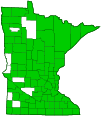bittersweet nightshade
(Solanum dulcamara)
Conservation • Weed • Wetland • Description • Habitat • Ecology • Use • Distribution • Taxonomy
Description |
Bittersweet nightshade is an exotic, sprawling, vine. It is native to Northern Africa, Asia, Europe, and the Indian Subcontinent. It has been widely introduced. It is now naturalized throughout the temperate zone of the Northern Hemisphere. It is found mostly in disturbed areas, including fence rows, hedges, gardens, yards, and waste areas, but it is also found in natural areas, including woodland openings, thickets, marshes, and bogs. It can be seen trailing over adjacent shrubs and bushes. It grows best under full or partial sun, in moist to moderately moist, loamy soil, but it can adapt to drier conditions and other soils. Bittersweet nightshade spreads by abundant underground, horizontal stems (rhizomes), and it often forms colonies. It is difficult to eradicate one it becomes established. A small piece of rhizome remaining in the soil can regenerate a new plant. The foliage is toxic, so gloves should be worn when removing the plant by hand. Young stems are purple and are hairless or sparsely covered with straight, stiff, upward-pointing hairs. Older stems are brown and woody. The leaves are alternate, triangular in outline, ¾″ to 3″ long, ⅔″ to 2″ wide, on long, slender leaf stalks. Some are unlobed, others are divided into a large terminal leaflet and two small basal leaflets or lobes. The margins are untoothed. The upper surface is hairless or sparsely covered with straight, stiff, upward-pointing hairs. The inflorescence is a 1″ to 3″ wide branched cluster of 6 to 12 flowers. The clusters are at the end of purple or violet, ⅔″ to 1½″ long stalks arising from the leaf axils and at the end of the stems. The individual flowers are on nodding, closely-clustered stalks. The flowers are ⅓″ to 1½″ wide. There are 5 purple or violet petals that are widely spreading, eventually curving backward, and form no tube at the base. There are 5 stamens with large yellow anthers projecting from the center of the petals. The anthers are fused into a cone around the style. The style is longer than, and protrudes from, the anther cone. The fruit is an oval, ¼″ long berry, green when young, turning yellow, then orange, and finally bright red when ripe. |
Height |
Climbs 2′ to 8′ |
Flower Color |
Purple or violet |
Similar Species |
Habitat |
Moist to moderately moist. Full or partial sun. Woodland openings, thickets, marshes, bogs, fence rows, hedges, gardens, yards, and waste areas. Loamy soil. |
Ecology |
Flowering |
June to September |
Pests and Diseases |
|
Toxicity |
The entire plant is considered poisonous. The berries are mildly poisonous, but the intensely bitter taste is enough to deter anyone. |
Use |
|
Distribution |
||
|
Sources |
|
| 11/9/2024 | ||
Nativity |
||
Native to Northern Africa, Asia, Europe, and the Indian Subcontinent. Introduced and naturalized in North America. |
||
Occurrence |
||
Common |
||
Taxonomy |
|
Kingdom |
|
Division |
Tracheophyta (Vascular Plants) |
Subdivision |
Spermatophytina (Seed Plants) |
Class |
|
Order |
Solanales (nightshades, bindweeds, gooseweeds, and allies) |
Family |
Solanaceae (nightshade) |
Subfamily |
Solanoideae (nightshades and allies) |
Tribe |
Solaneae (nightshades and jaltomatas) |
Genus |
Solanum (nightshades) |
Subgenus |
Solanum |
Section |
Dulcamara |
Subordinate Taxa |
|
A much hairier form, Solanum dulcamara var. villosissimum, has been described. However, hairiness varies widely across the species’ range, making it difficult to distinguish distinct varieties. Most sources do not recognize any varieties. |
|
Synonyms |
|
Dulcamara flexuosa Dulcamara lignosa Lycopersicon dulcamara Solanum asiae-mediae Solanum assimile Solanum borealisinense Solanum depilatum Solanum dulcamara var. dulcamara Solanum dulcamara var. villosissimum Solanum dulcamarum Solanum kieseritzkii Solanum kitagawae Solanum laxum Solanum lignosum Solanum littorale Solanum macrocarpum Solanum marinum Solanum persicum Solanum pseudopersicum Solanum ruderale Solanum rupestre Solanum scandens Solanum serpentini |
|
Common Names |
|
bitter nightshade bittersweet bittersweet nightshade blue nightshade climbing nightshade deadly nightshade european bittersweet fellenwort woody nightshade |
|
Glossary
Axil
The upper angle where the leaf stalk meets the stem.
Rhizome
A horizontal, usually underground stem. It serves as a reproductive structure, producing roots below and shoots above at the nodes.
Visitor Photos |
||
Share your photo of this plant. |
||
This button not working for you? |
||
Alfredo Colon |
||
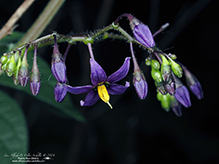 |
||
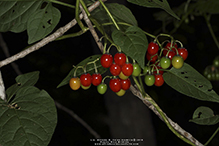 |
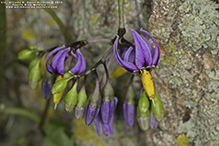 |
|
Robert Briggs |
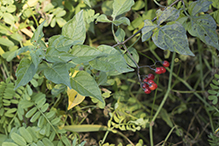 |
Bittersweet Nightshade at Whitetail Woods Park. |
Wayne Rasmussen |
 |
MinnesotaSeasons.com Photos |
||
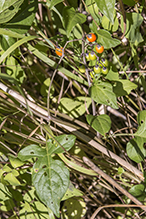 |
||
Vine |
|
|
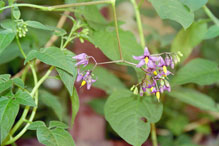 |
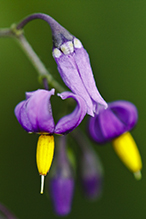 |
|
Inflorescence |
||
|
||
|
||
|
Flower |
|
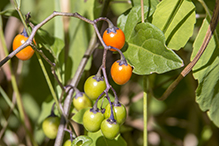 |
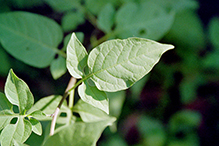 |
|
Infructescence |
Leaves |

Slideshows |
Solanum dulcamara - Bittersweet Nightshade |
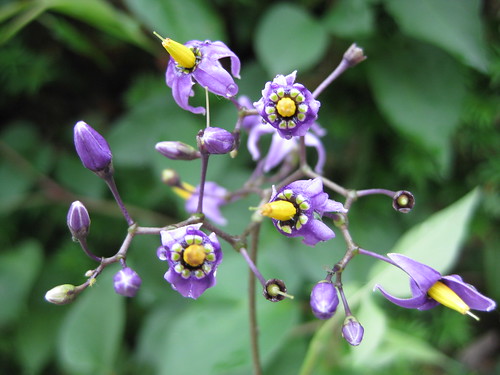
|
About
Solanaceae - Nightshade family. All parts of the plants are toxic. Bittersweet nightshade is a an invasive perennial plant native to Eurasia. Source: WeedUS Database of Plants Invading Natural Areas of the US © 2009 Virens. All rights reserved. |
Woody Nightshade |
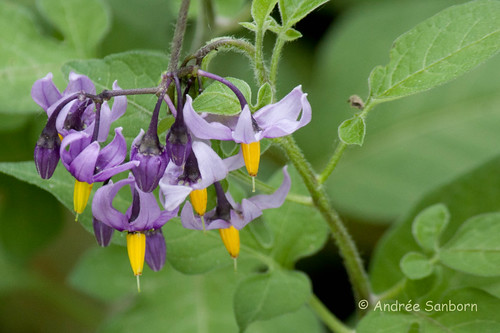
|
About
Solanum dulcamara Woody nightshade is also known as bittersweet nightshade, dulcamara, felonwood, and felonwort. In the Middle Ages the name dulcamara was written more properly as Amaradulcis, and literally means "bittersweet". Felonwood and felonwort are not as sinister as they sound; felon is not referring to criminals, but rather to whitlow, which is inflammation of the toe or finger around the nail. The berries were used to sure this problem when other methods had failed. The plant was used for many medical conditions, including dissolving blood clots (in bruises), for rheumatism, fever, and as a restorative. Farmers used it as a charm around the necks of animals they thought to be under an evil eye. Bittersweet berries are red rather than black like deadly nightshade. |
Solanum dulcamara (Bittersweet Nightshade) |
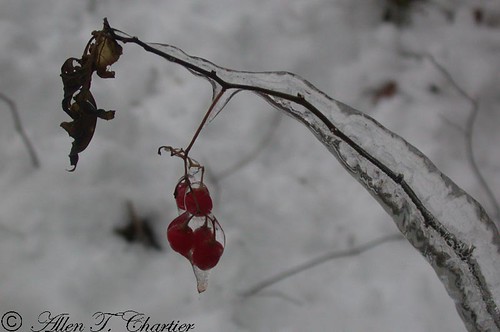
|
Solanum dulcamara BITTERSWEET NIGHTSHADE |
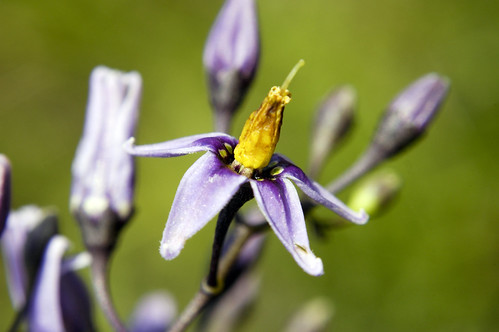
|
Solanum dulcamara L. |
About
Published on May 12, 2013 Plants of future: http://www.pfaf.org/user/Plant.aspx?LatinName=Solanum+dulcamara |

Visitor Videos |
||
Share your video of this plant. |
||
This button not working for you? |
||
|
Other Videos |
||
Solanum dulcamara, woody nightshade |
About
Uploaded on Sep 2, 2008 The beautiful red berries are capable of causing death if you eat too many. But the name gives the clue to why so few people are killed by its poisons. |
MyNature Apps; Identifying Bittersweet Nightshade, Solanum dulcamara |
About
Uploaded on Jul 4, 2011 How to identify Bittersweet Nightshade, Solanum dulcamara also known as bitter nightshade, blue bindweed, Amara Dulcis, climbing nightshade, fellenwort, felonwood, poisonberry, poisonflower, scarlet berry, snakeberry, trailing bittersweet, trailing nightshade, violet bloom, woody nightshade and deadly nightshade. www.mynatureapps.com, |
Bittersweet Nightshade (Solanum Dulcamara) - 2012-06-13 |
About
Published on Jun 15, 2012 Solanum dulcamara, also known as bittersweet, bittersweet nightshade, bitter nightshade, blue bindweed, Amara Dulcis, climbing nightshade, fellenwort, felonwood, poisonberry, poisonflower, scarlet berry, snakeberry, trailing bittersweet, trailing nightshade, violet bloom, or woody nightshade, is a species of vine in the potato genus Solanum, family Solanaceae. ------------ |
Solanum dulcamara |
About
Published on Jun 10, 2013 European Bittersweet is a Eurasian species that has established itself in North America. It is distantly related to both the potato and the tomato. The berries and leaves are mildly poisonous and pose a hazard to livestock. It is also related to the nightshades which can be very poisonous. |

Visitor Sightings |
||
Report a sighting of this plant. |
||
This button not working for you? |
||
Alfredo Colon |
Location: Albany, NY |
 |
| Diana Dragovich 9/16/2020 |
Location: Rosemount, MN creeping on fence and in lilac bushes |
| Alfredo Colon 8/21/2019 |
Location: Woodbury, Minnesota |
 |
| Alfredo Colon 8/2/2019 |
Location: Woodbury, Minnesota |
 |
| Chris Kelly 7/25/2017 |
Location: NE Brainerd, Crow Wing County, Minnesota Spotted the purple flowers among the large grapevine on my backyard chainlink fence. Read that the berries can be toxic to dogs, so I removed it. The vines were about 10 feet long, emanating from a woody stock of about 8 branches. |
|
| Joe Krause 7/23/2017 |
Location: International Falls this has been growing at my home since I purchased it in 2010, I didn't know what it was. |
|
| Robert Briggs 11/5/2016 |
Location: Whitetail Woods Regional Park |
 |
| Wayne Rasmussen 7/19/2016 |
Location: Keller Regional Park |
 |
| Mike 7/13/2014 |
Location: East of Royalton Mn Found out what it was and sprayed with Round-Up |
MinnesotaSeasons.com Sightings |
||
Bertram Chain of Lakes Regional Park Carpenter St. Croix Valley Nature Center Clifton E. French Regional Park Kellogg Weaver Dunes SNA, Kellogg Weaver Unit Margherita Preserve-Audubon Prairie Mary Schmidt Crawford Woods SNA Minnesota Valley NWR, Wilkie Unit Mound Spring Prairie SNA, North Unit Northern Tallgrass Prairie NWR, Touch the Sky Prairie Unit P.N. and G.M. Nelson Wildlife Sanctuary Prairie Creek WMA, Koester Prairie Unit Robert Ney Memorial Park Reserve |

|
Created: 10/7/2010 Last Updated: © MinnesotaSeasons.com. All rights reserved. |
